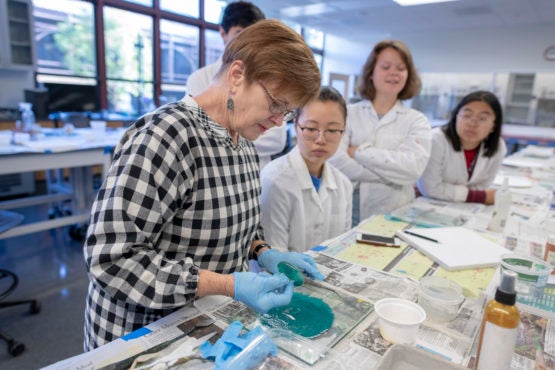If you walked the first floor of the Shriram Center for Bioengineering and Chemical Engineering at Stanford University in early September, you may have peered in on a lab full of students, decked out in lab coats, gloves, face masks and goggles. This would be no unusual sight in a chemistry lab, save for what the students were doing. With the utmost focus – and more than a little urgency – they were making art.
Go to the web site to view the video.
For three weeks, rising sophomores enrolled in the Sophomore College course, An Exploration of Art Materials: The Intersection of Art and Science, could be seen through the windows of Shriram 132 constructing canvases, making paper, mixing paints, sketching and painting. Through a combination of lectures, hands-on art labs and field trips, this course covers the history and science of art materials, starting with cave art from the Paleolithic era and addressing art forms from ancient Egypt and Greece, the Middle Ages, the Renaissance and modern times.
“A lot of artists don’t have any idea about some of the things they’re working with. It comes pre-packaged, they just leap right in. Sometimes these things are pretty dangerous,” said instructor Sara Loesch-Frank, an artist and lecturer in chemical engineering at Stanford. “We felt like this was important to teach, not just for the medical aspects but for the history too.”
The course requires some exposure to chemistry, but the students vary in terms of their interests and experiences in art and science. The class is co-taught by Curt Frank, the W. M. Keck Sr. Professor in Engineering, who is married to Sara.
Learning and doing

Students mix tempera paint, starting with egg yolks, and paint on a gessoed ground over wood. (Image credit: L.A. Cicero)
Over a decade ago, another faculty member – who was familiar with Sara and Curt’s frequent discussions about the science behind some of her experimental art processes – challenged them to teach a class that combined their areas of expertise. Sara was ready to do it but Curt had his reservations.
“The probability that I would really say something stupid was fairly high on my consciousness,” he recalled.
A couple years later, after taking some time to learn about art history and brainstorm potential lectures, which now amount to 20 hours, Curt agreed to give it a go. The experience, he said, has been “a real growth process” for him. But his willingness to step outside his comfort zone has motivated others, including graduate students in his lab who have audited the class and done their own research on the science of art materials.
Given the various chemistry backgrounds of the students, Curt’s lectures are taught at an introductory level. However, they cover a broad range of topics, including why pigments and dyes have colors, what kinds of binders hold the pigments together, how paintings and murals can be cleaned and the technologies of making paper, glass and ceramics.

Lecturer Sara Loesch-Frank mixes in ground minerals to create the desired color. (Image credit: L.A. Cicero)
“My expectation for the course is not that the students remember any of the details of the chemistry,” Curt said. “But the next time they go to a museum and look at a painting, I want them to have some idea that there’s something below the image and I want them to think about it.”
Each art lab entails 90 minutes of concentrated work on a piece that matches a particular lecture topic. For the students and instructors alike, the time flies. Art forms include sketching on rough surfaces with graphite and pastels, making paper, painting with egg tempera on wood and oil paint on canvas, and learning how to marble paper. Students mixed their own paints – the egg tempera lab featured eggs from the instructors’ own chickens – and could grind their own pigments. Pigment ingredients included cochineal, an insect that’s long been a component in natural red dyes, and clays dug up by Sara and Curt during their travels.
“I wanted to do an art intensive because I wanted to see what that would be like to make art in a rigorous, academic setting,” said Rachael Wang, ’20, a student in this year’s class. “It’s really cool having the lab portion where we can experiment and when I go into a museum or an exhibition, I’ll understand so much more about the materials.”
Field trips to Stanford’s Department of Special Collections and University Archives and the Cantor Art + Science Lab, as well as to the de Young Museum, Legion of Honor and Museum of Modern Art in San Francisco, round out the course. In the Special Collections, the class viewed illuminated lettering on vellum, parchment and paper. At the de Young, they went behind the scenes where conservators were restoring paintings and rebuilding frames. They even got to see how conservators wash pages of old books at the Legion of Honor, which Sara said scared her a bit the first time she saw it.
Being a better artist
The students complete an additional art project outside of class and write a paper explaining the science behind their art. Past projects have included stained glass, pottery, batik print (a dyeing process that relies on wax-resistance) and cyanotypes (a precursor to film photography).
None of the projects in the course are judged for artistic merit. Instead, Sara concerns herself with how the students engage with the materials. Still, by learning, thinking about, discussing, observing and experiencing how these art materials work, the students, of course, gain some new art skills.
“Materials and the artist are basically inseparable,” said Arthur Morris, an exchange student from Oxford University who studies physics and took the course to combine his scientific and artistic interests. “So, if you have a good knowledge of the materials, then you’re definitely going to be a better artist.”
Curt Frank is also a member of Stanford Bio-X.